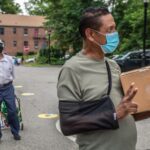Though COVID-19 has had sweeping implications, many immigrant groups in the United States have been disproportionately affected. The purpose of the present study is to explore the impact of COVID-19 on immigrant communities and how local immigrant-serving organizations (ISOs) have responded during the pandemic. The authors conducted in-depth qualitative interviews with executive directors and program coordinators of 31 ISOs and health clinics in Kentucky, North Carolina, and South Carolina. Findings highlight the needs of immigrants and refugees during the pandemic, including economic burden, lack of information, and limited access to testing and treatment for COVID-19. The authors find that ISOs have responded to these needs by providing basic supports, partnering with other local organizations to channel needed resources to immigrant communities, and collaborating with state-level entities to improve outreach, testing, and treatment. The authors also identify mechanisms that enabled the organizations to make nimble accommodations during the pandemic as well as the burden and compromises that these organizations have experienced. The authors argue that ISOs represent an important aspect of safety nets available for immigrants and provide insights into how other organizations can prepare for public health crises like COVID-19 in the future.
A Systematic Review on the Impact of Trauma-Informed Education Programs on Academic and Academic-Related Functioning for Students Who Have Experienced Childhood Adversity
The purpose of this study was to conduct a systematic review of the existing literature regarding trauma-informed education programs and their impact on academic and academic-related outcomes. The articles included for review (n=15) contained data on trauma-informed education programs implemented in preschool, primary/elementary, and high school settings. Academic and academic-related outcomes reported included attendance, disciplinary…

